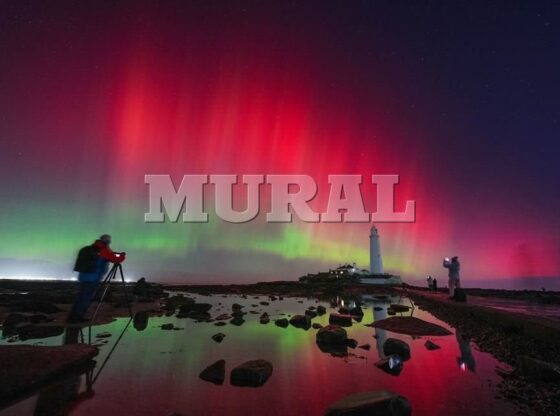Space meteorologists confirmed that the storms reached severe levels on Tuesday, triggering vibrant auroras that were seen in southern states such as Kansas, Colorado and Texas.
There were some impacts to GPS communications and the power grid, said Shawn Dahl of the US National Oceanic and Atmospheric Administration (NOAA) in a video posted on X.
In recent days, the Sun has emitted several bursts of energy called coronal mass ejections. Two have reached Earth, and at least one more is on the way and could arrive sometime on Wednesday.
Experts think this solar explosion could be the most energetic of the three and have issued a severe storm warning. How bright the auroras are and how far south they are visible will depend on when the explosion arrives and how it interacts with Earth’s magnetic field and atmosphere.
The Sun is in the peak phase of its 11-year activity cycle, making light displays more common and widespread. The colorful northern lights have decorated night skies in unexpected places and space weather experts say there are still more auroras to come.
The so-called northern and southern lights are commonly visible near the poles. But observers say the lights are reaching deeper into the United States and Europe because the Sun is undergoing a major change. Every 11 years, its magnetic poles change places, causing magnetic twists and tangles in the transition.
Last year, the strongest geomagnetic storm in two decades hit Earth, producing light displays across the Northern Hemisphere. And soon after, a powerful solar storm dazzled Arctic Circle observers as dancing lights appeared in unexpected places, including Germany, the United Kingdom, New England and New York.
The Sun’s active outbreak is expected to last at least until the end of this year, and it will be months before we know when solar activity will peak, according to NASA and NOAA.
Solar storms can bring more than colorful lights to Earth.
When fast particles and plasma collide with the Earth’s magnetic field, the electrical current is temporarily interrupted. Space weather can also cause interference to air traffic that is controlled by radio and satellites in orbit. Severe storms are capable of disrupting other radio and GPS communications.
In 1859, a severe solar storm triggered auroras as far south as Hawaii and set telegraph lines on fire, in an unusual event. And a 1972 solar storm may have detonated American magnetic mines in the sea off the coast of Vietnam.
Space weather experts can’t predict a solar storm months in advance. Instead, they alert relevant parties to prepare in the days before a solar explosion hits Earth.
Northern Lights forecasts can be found on NOAA’s Space Weather Prediction Center website or in an aurora forecast app.
It is advisable to observe them from a quiet, dark area, away from city lights, such as a park or forest. And check the weather forecast because clouds can cover up the show completely.

